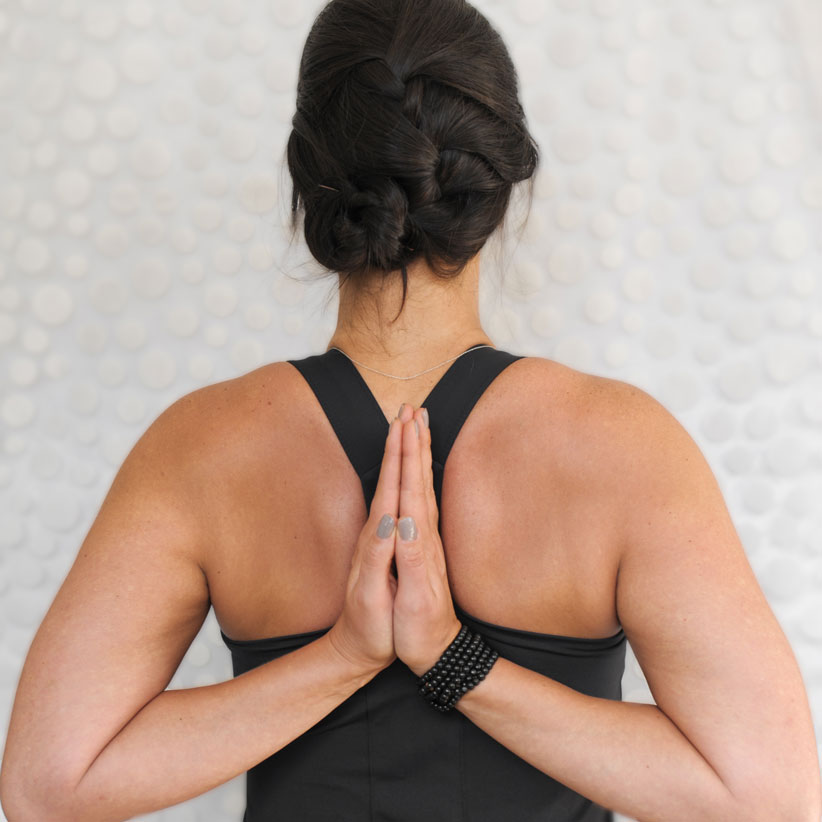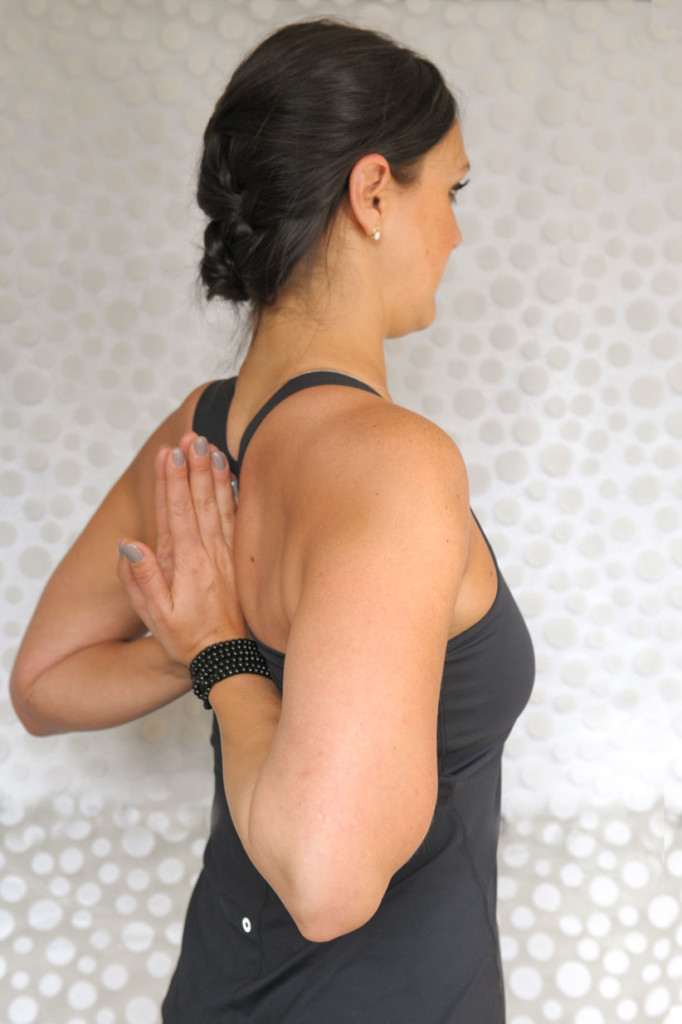
Still, there is an argument to be made about how the pose should be practiced not only to gain the most physically, but also to explore our true nature through the asana.
My shoulders have always been hyper-mobile and floppy to a fault. So it was never a big deal for me to practice paschima namaskara, reverse namaste. I could easily take my hands behind back, pressing my palms and fingers all the way together in prayer, and slide them up toward my neck while also drawing my shoulders and elbows back to keep the chest open. This, however, is not a great act of Yoga or skill I had fine-tuned with practice. It is merely a natural born “talent.”
On the other end of the spectrum are yoga practitioners who no matter how diligently and persistently they practice reverse namaste will never be able to come in to the full expression of this shoulder opener. Whether because of tightness in the pectorals or the anatomical structure of the shoulder the pose may be forever elusive. And perhaps it should be elusive for many since this pose requires that our shoulders rotate externally as our upper arm bones internally rotate.
Despite limitations, if this pose is practiced thoughtfully it is a great way to mitigate slouching. It opens the pectoral muscles as the shoulders draw back in socket and strengthens the muscles of the upper back as the shoulder blades press in toward the heart. Still, there is an argument to be made about how the pose should be practiced not only to gain the most physically, but also to explore our true nature through the asana.
For those like me who are highly flexible and find paschima namaskara easily accessible there is a desire to constantly push for more, a condition my teacher Natasha Rizopolous terms “being a sensation junkie.” It is possible to be too flexible and overstretch, stressing the tendons and ligaments of the delicate shoulder joint, originally intended to be more mobile than other joints to help us pick fruit from trees. When these tendons are chronically compromised it could lead to longterm instability in the joint and strain in the rotator cuff, the four tendons and muscles of the shoulder that create stability and mobility in the shoulder socket. There is no reason, other than maybe nailing some later regrettable yoga pose, to go beyond reasonable limits of the shoulder joint.
Then there are those with tight shoulders. Unlike their bendy counterparts, these students can be so preoccupied with pressing their palms together in the pose that they sacrifice opening the shoulders and chest altogether. In the effort to find prayer with their hands, they collapse the chest and fall back into the postural habit that may have tighten the pectorals in the first place: slouching. Simply by choosing to press the knuckles together or grab opposite elbows behind your back can alleviate this issue and keep the chest open.

In either case, whether your shoulders are tight or loose, we must remember the goal of the pose. If we decide to practice intelligently and let go of the external picture we can learn more about our Self, beyond just noticing whether our shoulders are tight or open. We can observe, and begin to think critically about, what habits and patterns of thought, samskaras, are guiding us into an unwise and potentially harmful position. Therein lies the Yoga and once again the asana becomes a vehicle for us to learn more about who we truly are.
Kristin Olson, E-RYT 500, MS is studio owner at Andover Home Yoga.
Photographer Hannah Latham is an emerging portrait and alternative process focused photographer from the Boston area. She is constantly building off of her life experiences and experimenting with new styles and techniques.
In the pose, the author is wearing top by Crane & Lion.
Kristin Olson (E-RYT 500, MS) is the studio owner at Home Yoga in Andover, Massachusetts – both their Chestnut Street and North Main Street locations. Her classes and teacher training programs combine Ashtanga’s emphasis on connecting breath with movement and Iyengar’s emphasis on proper alignment. It has been her experience that these seemingly disparate yoga traditions offer students the ability to quiet the mind while also strengthening and opening the body. Kristin’s teaching has been strongly influenced by internationally esteemed yoga teacher Natasha Rizopoulos, with whom she earned both her 200-hour and 500-hour Yoga Alliance-compliant teacher certificate. In addition to her teaching, she assists Natasha with YogaWorks teacher trainings and at Kripalu Yoga Center. She also studies regularly with revered master Iyengar yoga teacher Patricia Walden.
